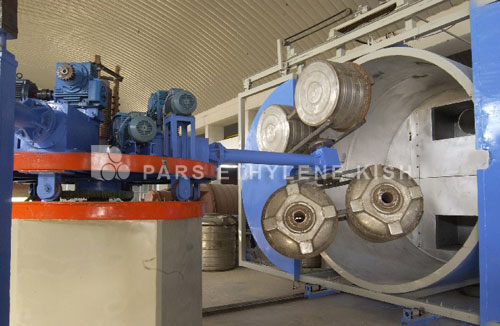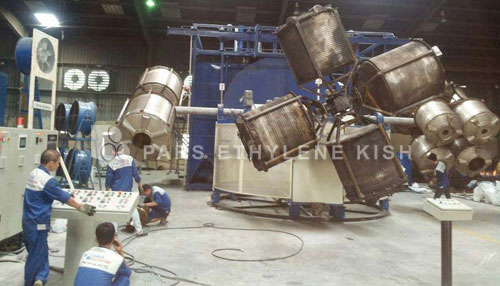
What is rotational molding?
rotational molding
rotational molding is a new technology in process of production of plastic parts. Due to the functionality and quality of the rotary method, is rapidly gaining of global acceptance. In this method, due to the ability of production of very small to very large parts, as well as very quick and cheap molding, it is possible to achieve desired production as soon as possible, and in realm of competition, it has a very high potential. Production of all kinds of integrated parts (rotational molding) - Types of polyethylene manholes - Types of polyethylene tanks for water and chemicals material- Types of warning signs for driving (polyethylene), Production of various types of Polyethylene manholes and ready for installation in place from diameter of 600 mm to 1200 mm and with different heights. This company has ability to provide services with a micronized mill with special grade for production of powder from polyethylene materials in size of 300 to 1200 microns.

In following, following topics are discussed:
- Polyethylene in rotational molding
- Definition and familiarity with rotational molding
- Features of rotational molding process
- Optimal time of heating cycle in rotational molding
rotational molding or modern molding technology, as we know it today, developed during World War II and afterwards. Since then, researchers and manufacturers have discovered new amazing aspects of this process. It is not exaggeration to say that none of plastic forming processes are comparable in terms of flexibility in production of this method.
Less than 30 years after development of rotational molding and introducing of it as a remarkable way of making plastics in the world, this industry entered Iran. Although manufacturers of rotational molding industry in Iran, during last two decades, in terms of increasing production capacity have done great work, but many of scientific complex aspects of this process are unknown to them.
Polyethylene in rotational molding
Low and medium density polyethylene, marketed in the mid-1940s (High density polyethylene was invented in 1957). Supply of these materials led to serious changes in rotational molding process. Since the types of polyethylene were supplied in form of granule and these granules were not suitable for Sintering, powder making method was used with using from twist wire brushes. Disney's Mickey Mouse dolls in 1953 were first of polyethylene products that were manufactured by rotational molding. This method of powder production was not very efficient, until in 1955 Palman's mills entered market. These mills were capable of producing fine and uniform powders of all types of plastics with low Softening Point. Production of powder polyethylene with high chemical resistance and low relative price, was evolution in production of variety of storage tanks and plastic transportation. Massive and commercially production of polyethylene powder for rotational molding process, in 1961, began by the US Chemical Industry Company.
In the early years, polyethylene of injection grade was used for this process. Soon competition between raw material suppliers to produce special grades of this process began. Although polyethylene is not suitable for contact with aromatic hydrocarbons such as Furan and pyridine and Halogenated hydrocarbons such as Alkyl halides and Aryl halide, but market for production of small and medium tanks from polyethylene, was expanding, but this weakness of polyethylene created a sense in minds of polymer researchers about its elimination.
Polycarbonate is first material used in rotational molding with transparency, thermal resistance, impact resistance and high strength. This material was discovered in 1957, but did not reach commercial production until 1968.
Research continued to find of a material with better properties. Until 1970, cross linked polyethylene was marketed to improve chemical, thermal properties and impact resistant in low temperature by Philips Chemical Company.
In 1980s created dramatic change in rotational molding industry. One of the most important events of this decade, introduction of Low Density Polyethylene (LDL) that was conducted by American DuPont Company. This material quickly became most common material in rotational molding process.

Definition and familiarity with rotational molding
Rotational molding process is one of the processes of plastic molding that is used at high temperature, low pressure and open mold to produce hollow and integrated parts.
In rotational molding, with lowest cost are produced very complex forms with little waste. This process is carried out at atmospheric pressure, Polymer materials stick to each other and to the interior surface of mold, and cover it, during heating. Polymeric materials used in this process are usually powder or liquid.
Features the rotational molding process
One of the features of rotational molding process is that at the beginning, both molds and plastic materials are at ambient temperature. During the process, plastic materials are heated to their melting point, and after the cooling cycle, return to ambient temperature.
During the heating cycle, mold that is in the furnace, is heated, and heat is transmitted through the wall to plastic powders. This factor causes the powders stick to each other and wall of mold cavity. Therefore, a loose powder mass is formed adjacent to the mold cavity wall, after that, with heating cycle continuing, powder mass is coagulated, and air bubbles between powder particles get small and smaller. As long as powder mass becomes uniform melt, and all bubbles disappear. It should be noted that these bubbles cannot move to the surface because of high viscosity of melt, and where they are, remain, until get small and smaller, and disappear at the end of heating cycle.
Temperature and time parameters in heating and cooling cycles have important effects on the quality of final piece. If temperature of heating cycle is low or its time is short, powders do not have enough time for Sintering and fix, and remaining bubbles in the wall of piece will reduce its physical and mechanical properties. Excessive heating, due to the degradation of the polymer structure, will cause low resistance to the impact, loss of color and early failure of piece in its useful life.

Optimal time of heating cycle in rotational molding
Generally, optimal heating cycle time in the production units is obtained by trial and error. One of the common methods for control of product quality is, provide a very thin shear of the piece wall and to check status of bubbles on it. Presence of large number of bubbles is indicator of incomplete sintering of piece. If there are no bubbles, then there are two possible modes, first mode is that the sintering process is precisely complete and desired quality is achieved, but there is also a possibility that piece is too hot. Optimal time of heating cycle is state that there are very few amounts of bubbles at the inner surface of the piece at the desired cut. One of the other ways to check the quality of piece, is seeing and smelling of its inner surface. Interior surface of a piece with good quality should be perfectly smooth and free from any odor other than the intrinsic odor of polymer. If inner surface of the piece is powdery or wavy and rough, full heating cycle and optimal quality are not achieved, and if it is very polished and have unpleasant smell, sintering was too much and polymer degradation was caused by the presence of heat and oxygen. If the heating cycle time is optimal and suitable, cooling method will also have an important effect on the quality of final piece. In rotational molding industry, cooling phenomenon outside from mold creates an unbalanced cooling rate, and this problem, increases likelihood of causing irregularities and waves in the piece. Slow cooling (using airflow) increases strength and rigidity and reduces impact resistance, and fast cooling (using airflow with water spraying) results in greater toughness and less rigidity of the final piece.

Benefits of rotational molding process
One of the most important advantages of this process, possibility of producing of large and small pieces without welded line and integrated and hollow with very complex shapes. Many of these complex shapes cannot be produced with any other plastic forming process.
Due to the low pressure in this process, can use lightweight and simple machines. Time required to make templates is also much shorter than other processes. Compared to other processes that require pressure to transfer fluid, there is no need for pressure in this process, therefore, there is less stress on the polymer, and also, high impact resistance and chemical resistance are other advantages of parts produced with this process. Due to the rotation of molding around the two axes inside the furnace, hot air circulation and creation of a plastic layer on the inner wall of mold, pieces with thin-walled sections and high volume can be produced in this process. Low thickness of piece wall also reduces consumption of plastic materials, shortens cycle time and ultimately reduces cost of products. Sintering in this method, creates more uniform thicknesses compared with other forming methods of hollow plastic parts. This process is also suitable for producing varieties of various shapes or small and large sizes simultaneously and in a production cycle.
Possibility of quickly changing of mold, provides ability to production of custom parts in shortest time for the manufacturer. Meanwhile, since only the interior wall of the mold is in contact with plastic, no time is needed to clean or change of material. In the rotational molding process, it is possible to production of two-colored or two-component double-layer products without need to multiple molds or complex machines. In addition with this method, hollow two-layer hollow pieces and multi-layer, with foam or without foam, can easily be produced. Also, using this process, can prepare pieces with components of metals, plastics, or wood.
Some pieces can be designed without slope angles, while this is not possible in processes of closed mold.
Retrieved from: book of rotational molding- by Engineer Barmak Qanbarpour Juybari, Engineer Alireza Mirblok




